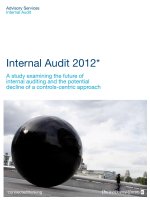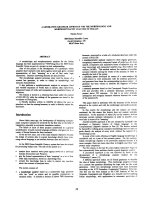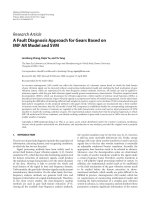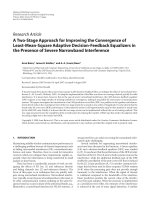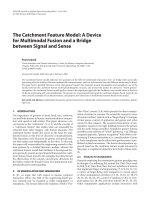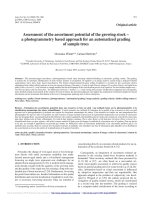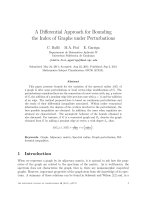THE 5E INSTRUCTIONAL MODEL: A LEARNING CYCLE APPROACH FOR INQUIRY-BASED SCIENCE TEACHING
Bạn đang xem bản rút gọn của tài liệu. Xem và tải ngay bản đầy đủ của tài liệu tại đây (60.78 KB, 10 trang )
<span class="text_page_counter">Trang 1</span><div class="page_container" data-page="1">
<b>The 5E Instructional Model: A Learning Cycle Approach for Inquiry-Based Science Teaching </b>
Lena Ballone Duran
<i><small>Bowling Green State University, OH, USA</small></i>
<small>The implementation of inquiry-based teaching is a major theme in national science education </small>
<i><small>reform documents such as Project 2061: Science for All Americans (Rutherford & Alhgren, 1990) and the National Science Education Standards (NRC, 1996). These reports argue that inquiry </small></i>
<b><small>needs to be a central strategy of all science curricula. Using a learning cycle approach in the </small></b>
<small>classroom helps to facilitate inquiry practices because learning cycles focus on constructivist principles and emphasize the explanation and investigation of phenomena, the use of evidence to back up conclusions, and experimental design. Although there are several variations of learning cycles, the one that is highlighted in this manuscript as a method to support inquiry-based teaching </small>
<i><small>is the 5E Instructional Model (Bybee & Landes, 1990). The use of this model in several science </small></i>
<small>education professional development programs is also addressed. </small>
<i><b>Introduction </b></i>
A flurry of science education reform efforts are sweeping the United States and incorporating state and national level initiatives, high-stakes testing, and funding conditions. Two of these major national reform efforts that aim to develop
<i>scientifically literate citizens include the National Science Education Standards (hereinafter called The Standards) (National Research Council [NRC], 1996) and </i>
<i>Project 2061: Science for All Americans (Rutherford & Alhgren, 1990). The </i>
<i>Standards for science teaching indicate that what students learn is influenced by the </i>
<i>pedagogical methods by which they are taught. On the other hand, Project 2061: </i>
<i>Science for All Americans is based on the conviction that a scientifically literate </i>
person is one who is cognizant that science, mathematics, and technology are human enterprises dependent upon one another. Both reform reports reveal that science teaching should actively engage students, incorporate cooperative learning, and de-emphasize the rote memorization of facts. In addition, the inclusion of inquiry-based teaching methodologies is a prominent theme permeating these reform documents. This paper discusses a specific learning cycle that encourages inquiry in science classrooms.
<i><b>Inquiry-Based Teaching </b></i>
Inquiry may be referred to as a technique that encourages students to discover or construct information by themselves instead of having teachers directly reveal the information (Uno, 1999). The implementation of inquiry has had a place in science
</div><span class="text_page_counter">Trang 2</span><div class="page_container" data-page="2">classrooms for less than a century. Before 1900, most educators viewed science as a body of facts that students were to learn through memorization and direct instruction. However, by the 1950’s and 60’s, an inquiry-based rationale became more and more
<i>visible (National Research Council [NRC], 2000). Recently, Project 2061: Science </i>
<i>for All Americans (Rutherford & Alhgren, 1990) and The Standards (NRC, 1996) </i>
<i>argue that inquiry needs to be a central strategy of all science curricula. The </i>
<i>Standards emphasize the inclusion of inquiry-based lessons in the science classroom </i>
<i>as part of the process by which new knowledge is acquired. Specifically, The </i>
<i>Standards describe the inquiry process as follows: </i>
Inquiry is a multifaceted activity that involves making observations; posing
questions; examining books and other sources of information to see what is already known; planning investigations; reviewing what is already known in light of
experimental evidence; using tools to gather, analyze, and interpret data; proposing answers, explanations, and predictions; and communicating the results. (p. 23) However, the shift to inquiry-based pedagogical practices in the classroom may necessitate a transition from textbook-dependency as the main resource of science information to a more hands-on approach, where students are central to the learning episodes. Recent research findings have shown that an inquiry-based approach is beneficial to students and that even young children can learn through inquiry processes (Etheredge & Rudnitsky, 2003). A recent publication from the National Research Council (Bransford, Brown, & Cocking, 1999) illustrates a broad
consensus about learning processes. Related to the findings discussed in this
document, the National Research Council (2000) reveals that “a classroom in which students use scientific inquiry to learn is one that resembles those that research has found as being the most effective for learning for understanding” (p. 124).
Even though inquiry-based reform efforts are widespread around the country, many educators may be uncomfortable or unaware of ways to design science lessons that support inquiry learning. However, the transfer and application of inquiry-based practices in the classroom can be accomplished by using practical tools or templates for instructional design. For instance, one strategy that can be helpful to teachers, as they embark on the development of inquiry-based lessons, involves the use of a learning cycle approach (Abraham, 1997). The history of the learning cycle method dates back to the Science Curriculum Improvement Study (SCIS), an elementary school science curriculum project during the 1950’s (Atkin & Karplus, 1962). A learning cycle model divides instruction into various phases based upon an established planning method, and is consistent with contemporary theories about how individuals learn, constructivist ideas of the nature of science, and the developmental theory of Jean Piaget (Piaget, 1970). A compelling case for
implementing a learning cycle as a strategy to design inquiry-based science lessons is illustrated by Abraham (1997). This report synthesizes the findings from several
</div><span class="text_page_counter">Trang 3</span><div class="page_container" data-page="3">research studies such as Abraham and Renner (1986), Ivins (1986), McComas III (1992), Raghubir (1979), and Renner, Abraham, and Birnie (1985) and suggests that, in comparison with traditional pedagogy, the learning cycle can result in better
retention of science concepts, higher achievement in science, superior process skills, improved attitudes toward science and science learning, and improved reasoning abilities.
The use of a learning cycle approach in the classroom differs greatly from traditional teaching methodologies. For example, learning cycles focus on constructivist
principles and emphasize the explanation and investigation of phenomena, the use of evidence to back up conclusions, and experimental design. In contrast, traditional pedagogical approaches stress the progression of skills and techniques, the delivery of ready-made information, and knowledge of the outcome of an investigation prior to it being conducted (Abraham, 1997). Although there may be several variations of learning cycles, the one that will be highlighted here as a method to support inquiry-based teaching is the 5E Instructional Model (Bybee & Landes, 1990).
<i><b>The 5E Instructional Model </b></i>
The 5E Instructional Model (Bybee & Landes, 1990) can be used to design a science lesson, and is based upon cognitive psychology, constructivist-learning theory, and best practices in science teaching. The cycle appears in Figure 1 and consists of
<i>cognitive stages of learning that comprise engage, explore, explain, elaborate, and </i>
<i>evaluate. Bybee (1997) declares that “using this approach, students redefine, </i>
reorganize, elaborate, and change their initial concepts through self-reflection and interaction with their peers and their environment. Learners interpret objects and phenomena, and internalize those interpretations in terms of their current conceptual understanding" (p. 176). Science teachers and curriculum developers may integrate or apply the model at several levels. The model can be the organizing pattern of a sequence of daily lessons, individual units, or yearly plans (Bybee, 1997). Each phase of the 5E Instructional Learning Cycle, as it has been modified from Bybee, is now described.
<i><b>Engagement.</b></i>In this first phase of the cycle, the teacher aims to assess student prior knowledge and/or identify possible misconceptions. This student-centered phase should be a motivational period that can create a desire to learn more about the upcoming topic. Students may brainstorm an opening question or ask themselves: “What do I already know about this topic?” Discrepant events, demonstrations, questioning, or graphic organizers such as KWL charts may be included to create interest or generate curiosity. A KWL chart asks students to brainstorm and record
<i>what they Know, Want to know, and (eventually) have Learned about the topic. The </i>
KWL chart is used to pre-assess student prior knowledge and is oftentimes referred to throughout the duration of the lesson. The instructional task is identified.
</div><span class="text_page_counter">Trang 4</span><div class="page_container" data-page="4">However, this phase does not serve as a time to lecture, define terms, provide explanations, or record definitions.
<i><small>Figure 1. The 5E Instructional Model. </small></i>
<i><b>Exploration. Following an engagement phase that promotes a mental focus on the </b></i>
concept, the exploration phase now provides the students with a common, concrete learning experience. This phase is also student-centered and incorporates active exploration. Students are encouraged to apply process skills, such as observing, questioning, investigating, testing predictions, hypothesizing, and communicating, with other peers. This phase of the learning cycle tends to incorporate the main inquiry-based activity or experience, which encourages students to develop skills and concepts<small>. </small>The teacher’s role is one of facilitator or consultant. In addition, students are encouraged to work in a cooperative learning environment without direct
instruction from the teacher. This phase is also unique because the students are given a “hands-on” experience before any formal explanation of terms, definitions, or concepts are discussed or explained by the teacher.
<i><b>Explanation. A “minds-on” phase follows the exploration phase, and this is more </b></i>
teacher-directed and guided by the students’ prior experience during the exploration phase. The explanation phase enables students to describe their understanding and pose questions about the concepts they have been exploring. It is likely that new questions will be generated. The explanation phase is an essential, minds-on part of the 5E lesson. Before the teacher attempts to provide an explanation, the students
</div><span class="text_page_counter">Trang 5</span><div class="page_container" data-page="5">must first have the opportunity to express their own explanations and ideas. Thus, the initial part of the explanation phase is a time for the teacher to serve as a facilitator and ask the students to describe and discuss their exploration learning experiences. After the students have had the opportunity to share their own explanations, the teacher introduces scientific and technical information in a direct manner. This phase includes clarification of student misconceptions that may have emerged during the engagement or exploration phases. Formal definitions, notes, and labels are
provided. The teacher may also decide to integrate video, computer software programs, or other visual aides to help with student understanding. The students should then be able to clearly explain the important concepts to the teacher and to their peers.
<i><b>Elaboration. The activities in this phase of the learning cycle should encourage </b></i>
students to apply their new understanding of concepts, while reinforcing new skills. Students are encouraged to check for understanding with their peers, or to design new experiments or models based on the new skills or concepts they have acquired. The goal of this phase is to help develop deeper and broader understandings of the concepts. Students may conduct additional investigations, develop products, share information and ideas, or apply their knowledge and skills to other disciplines. This is a great opportunity to integrate science with other content areas. Elaboration activities may also integrate technology, such as web-based research or WebQuests
<i><b>Evaluation. Assessment in an inquiry-based setting is very different to that in </b></i>
traditional science lessons. Both formal and informal assessment approaches are appropriate, and should be included. For instance, the use of non-traditional forms of assessment, such as portfolios, performance-based assessment, concept maps,
physical models, or journal logs may serve as significant evidence of student learning. During an inquiry-based lesson, assessment should be viewed as an ongoing process, with teachers making observations of their students as they apply new concepts and skills and looking for evidence that the students have changed or modified their thinking. Students may also have the opportunity to conduct self-assessment or peer-self-assessment. However, the evaluation may also include a summative experience such as a quiz, exam, or writing assignment.
Although the 5E Model has just been explained in serial order, it is often necessary to reverse back into the cycle before again going forward. For instance, numerous explore/explain rotations may need to occur before the students are ready to transition to the elaboration phase. The teacher may move back and forth several times within the Es, or may include an additional engagement prior to starting an elaboration phase. The cycle is very flexible and dynamic. It may take many days to complete the lesson or unit. It is not necessary to complete one learning cycle each day that science is taught. The model is designed to facilitate conceptual change and contribute to more consistent and coherent science instruction (Bybee, 1997).
</div><span class="text_page_counter">Trang 6</span><div class="page_container" data-page="6">Several teacher-developed 5E lesson plans are available from TAPESTRIES (n.d.). Also, Duran (2003) contains a lesson that engages students in inquiry following a 5E design, and an abbreviated version of this lesson is provided in Appendix A.
<i><b>Applications of the 5E Instructional Model </b></i>
The 5E instructional planning model has been integrated, as a core instructional design strategy, in many science classrooms in the Northwest Ohio region. Specifically, it has been a significant part of the reform-based professional
development programs conducted by science educators and scientists from Bowling Green State University and The University of Toledo. This group has worked with K-12 educators to create 5E lessons and unit plans that support science courses of
<i>study and The Ohio Academic Content Standards for Science. </i>
Included in these grant-funded programs are TAPESTRIES (Toledo Area Partners in Education - Support Teachers as Resources for Improving Elementary Science), a 5-year project funded by the National Science Foundation, and Project ASTER (Active Science Teaching Encourages Reform), a 2-year project funded by the Improving Teaching Quality Program of the Ohio Board of Regents. Both projects are
collaborative efforts between two large midwestern universities and urban and suburban school districts. Major goals of both projects are to:
1. provide effective and sustained professional development in science content, pedagogy, and assessment for elementary teachers,
2. implement quality inquiry-based science curriculum and instruction,
3. coordinate curriculum, classroom practice, and student assessment with the district-adopted science courses of study and statewide curriculum models and assessments, and
4. enhance the science content knowledge of elementary teachers in life, physical, and earth/space science.
Although the projects differ slightly in their academic year activities, a core 2-week summer institute experience is similar for all of the teachers. The summer institute is designed to encourage teachers to explore their district-adopted inquiry-based
science kits in a hands-on fashion. A scientist and science educator team facilitates each session using 5E Models as the guiding framework. At the end of the summer institute, the teachers develop their own 5E unit plans based upon the needs of their students. Approximately 1,200 classroom teachers from the participating districts received extensive staff development in science content, pedagogy, and student assessment. A recent study released by The Urban Affairs Center from The University of Toledo reveals the positive effects and impact of the TAPESTRIES
</div><span class="text_page_counter">Trang 7</span><div class="page_container" data-page="7">program on student achievement. A complete copy of the study is available from University of Toledo (n.d.).
A relatively new project, PRISM (Partnership for Reform through Inquiry in Science and Mathematics), is in its first year of implementation at Bowling Green State University with funding provided by the National Science Foundation’s Graduate Teaching Fellows in K-12 Education Program. Teams consisting of a cooperating teacher and a natural science or mathematics graduate student are working to introduce hands-on inquiry in science and mathematics classrooms into four school districts. Approximately 25 teams, over a 3-year time frame, will develop
comprehensive 5E Model unit plans that span the entire school year.
The ultimate goal of these projects is to improve student learning by conducting sustained teacher professional development. The projects were designed to help prepare scientifically literate students, who can comprehend and use science, while being successful on high-stakes statewide science assessments.
<i><b>Effectiveness of the 5E Model </b></i>
A qualitative analysis of TAPESTRIES and Project ASTER final evaluations and participant journals have yielded a prominent theme--that the 5E Model is an
effective way to design inquiry-based science lessons that enhance student learning. Sample teacher responses that support this theme are as follows:
Using the 5E Model will help me to be sure of designing meaningful, purposeful lessons for my students each time I teach science. I appreciate being sure that I am connecting to previous knowledge [engage], giving them meaningful, hands-on activities [explore], and being sure to assess specific skills that I want the
<i>students to learn [evaluate]. (TAPESTRIES teacher) </i>
By following the 5E Model, I will be able to assess the students’
knowledge before the exploration activity starts so that their evaluations will be appropriate for their academic ability level. (TAPESTRIES teacher) The 5E planning guide enables teachers to personalize lessons according to student needs. Educators often teach chapters or units from the order that is presented in the book. However, various and flexible teaching enables children with attention problems to stay focused. The 5E Model is a tool for teachers to engage the students with topics they may not have much interest in or prior knowledge about. (Project ASTER teacher)
<i> </i>
In order for students to learn and gain an understanding of science concepts, they must be actively engaged in their own learning. They must be lead by their
</div><span class="text_page_counter">Trang 8</span><div class="page_container" data-page="8">teacher to discover things. Teachers must guide their students in directions that will help them observe/discover to correct their own misconceptions. It is this inquiry learning that leads to true learning. A 5E plan helps set-up lessons in a manner that supports this type of teaching. (Project ASTER teacher)
One year after the first cohort of Project ASTER teachers underwent their
professional development, a follow-up question about their use and implementation of the 5E Model was sent to 30 participants. A sample of teacher’s responses
follows:
After the exploration, the class is more comfortable with how to explain; therefore, increasing their problem solving background and they become better writers too based on their confidence to explain more completely. The students who may have weaknesses in reading and writing really seem to excel with the 5E lesson planning--the plan encompasses all modalities of learning.
I have used the 5E Model and notice that the students are more motivated to learn the topic after I engage them in the beginning. The extend phase allows them to relate science to other subject areas so they see the purpose of what’s being taught.
A prolonged engagement period draws in the students who are more reserved--or just disinterested--into sharing their ideas and opinions. These students are more likely to stay with the lesson once they've invested something in it. Exploring scientific applications with hands-on activities helps the students immediately realize that these topics are relevant to their lives and perhaps connected to something they’ve observed or have wondered about.
After participation in the projects, the teachers are equipped with new skills and an improved confidence level to teach life, physical, and earth science in an inquiry-based environment. Teachers also argue that they are more comfortable teaching science after their participation in the projects. This improved confidence level transfers into the classroom and yields an exciting and dynamic place for student learning.
<i><b>Conclusion </b></i>
A national vision of science teaching and learning is being promoted that accentuates the need to restructure science education. Several national reform documents
illustrate the need to make science classrooms across the country active and inquiry-based environments. With much research to support inquiry-inquiry-based teaching and learning, many teachers are opting for this non-traditional teaching approach. The incorporation of learning cycles in the classroom aids teachers in the pursuit of the
</div><span class="text_page_counter">Trang 9</span><div class="page_container" data-page="9">development of effective inquiry-based science lessons. The 5E Instructional Model serves as a flexible learning cycle that assists curriculum developers and classroom teachers create science lessons that illustrate constructivist, reform-based, best teaching practices.
<i><b><small>References </small></b></i>
<i><small>Abraham, M. R. (1997). The learning cycle approach to science instruction (Research matters - To the science teacher, </small></i>
<small>No. 9701). Columbia, MO: The National Association for Research in Science Teaching. </small>
<i><small>Abraham, M. R., & Renner, J. W. (1986). The sequence of learning cycle activities in high school chemistry. Journal of Research in Science Teaching, 23(2), 121-143. </small></i>
<i><small>Atkin, J. M., & Karplus, R. (1962). Discovery or invention? The Science Teacher, 29(5), 45-51. </small></i>
<i><small>Bransford, J. D., Brown, A. L., & Cocking, R. (Eds.). (1999). How people learn: Brain, mind, experience, and school. </small></i>
<small>Washington, DC: National Academy Press. </small>
<i><small>Bybee, R. (1997). Achieving scientific literacy: From purposes to practices. Portsmouth, NH: Heinemann Publications. </small></i>
<small>Bybee, R., & Landes, N. M. (1990). Science for life and living: An elementary school science program from Biological </small>
<i><small>Sciences Improvement Study (BSCS). The American Biology Teacher, 52(2), 92-98. Duran, L. B. (2003). Investigating brine shrimp. Science Activities, 40(2), 30-34. </small></i>
<i><small>Etheredge, S., & Rudnitsky, A. (2003). Introducing students to scientific inquiry: How do we know what we know? </small></i>
<small>New York: Pearson Education. </small>
<small>Ivins, J. E. (1986). A comparison of the effects of two instructional sequences involving science laboratory activities </small>
<i><small>(Doctoral Dissertation, University of Cincinnati, 1985). Dissertation Abstracts International, 46(8), 2254A. </small></i>
<small>McComas III, W. F. (1992). The nature of exemplary practice in secondary school science laboratory instruction: A </small>
<i><small>case study approach (Doctoral Dissertation, University of Iowa, 1991). Dissertation Abstracts International, 52(12), </small></i>
<small>4284A. </small>
<i><small>National Research Council. (1996). National science education standards. Washington, DC: National Academy Press. National Research Council. (2000). Inquiry and the national science education standards: A guide for teaching and </small></i>
<i><small>learning. Washington, DC: National Academy Press. </small></i>
<i><small>Piaget, J. (1970). Structuralism (Chaninah Mascheler, Trans.). New York: Harper and Row. </small></i>
<i><small>Raghubir, K. P. (1979). The laboratory-investigative approach to science instruction. Journal of Research in Science Teaching, 16(1), 13-18. </small></i>
<small>Renner, J. W., Abraham, M. R., & Birnie, H. H. (1985). Secondary school students’ beliefs about the physics </small>
<i><small>laboratory. Science Education, 69(5), 649-663. </small></i>
<i><small>Rutherford, F. J., & Alhgren, A. (1990). Project 2061: Science for all Americans. New York: Oxford University Press. </small></i>
<small>TAPESTRIES (n.d.). Retrieved February 20, 2004, from . (Follow the </small>
<i><small>Science Kits & Resources link.) </small></i>
<i><small>University of Toledo (n.d.). Urban affairs center. Retrieved February 20, 2004, from . </small></i>
<small>Uno, G. (1999). Handbook on teaching undergraduate science courses: A survival training manual. Independence, KY: Thomson Custom Publishing. </small>
</div><span class="text_page_counter">Trang 10</span><div class="page_container" data-page="10"><b>Appendix A </b>
<i><b><small>Abbreviated 5E Lesson for Investigating Brine Shrimp </small></b></i>
<i><b><small>Objectives: Students will: </small></b></i>
<small>1. Design an investigation to test the hatching of brine shrimp eggs. 2. Organize data from an experiment. </small>
<b><small>3. Draw conclusions about brine shrimp optimal conditions. </small></b>
<i><b><small>Grade Level: 6-12 Materials: (per team) </small></b></i>
<b><small>• Clear plastic cups or jars (i.e., hatching containers) </small></b>
<small>• Masking tape </small>
<small>• One vial of brine shrimp eggs </small>
<small>• Small measuring spoon for brine shrimp eggs • Graduated cylinders and beakers </small>
<small>• Microscope and microscope slides </small>
<i><small>• Kosher salt or rock salt </small></i>
<i><small>• Student Sheet: Observe/Infer graphic organizer </small></i>
<small>• Hand Lens </small>
<i><b><small>• Long Term Investigation rubric </small></b></i>
<small>Phase Event Engagement • Teacher disperses Mystery Objects (i.e., brine shrimp eggs) to each </small>
<small>student team and does not yet inform the students that the Mystery Objects are called brine shrimp eggs. </small>
<small>• Students record and share observations and inferences on graphic organizer. </small>
<small>• Students suggest ways to hatch brine shrimp eggs. </small>
<small>Exploration • Student teams investigate optimal conditions for the hatching of brine shrimp by designing their own controlled experiments. • Make and record observations over a 2-week period. </small>
<small>Explanation • Use Jigsaw cooperative learning strategy to move students to new teams to share experimental design and results. </small>
<small>• Teacher leads class discussion about brine shrimp and components of a controlled experiment (using the student experiments as the focus of the discussion). </small>
<small>Elaboration • Based upon data and results, each team designs a new brine shrimp experiment to explore a different variable. </small>
<small>• Create a classroom newsletter or PowerPoint presentation to share findings with class. </small>
<i><small>• Conduct a Research Share-A-Thon day. </small></i>
<small>Evaluation </small> <i><small>• Use the Long Term Investigation rubric to evaluate students. </small></i>
<small>• Informal checklist during exploration to evaluate process skills. For the full 5E lesson plan, please see: </small>
<i><small>Duran, L. B. (2003). Investigating brine shrimp. Science Activities, 40(2), 30-34. </small></i>
</div>

